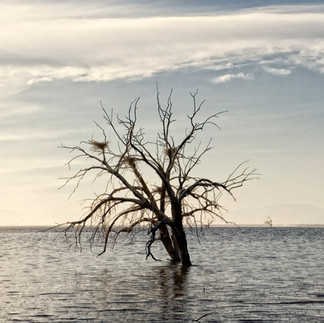
Since the first time I saw images from Richard Misrach's 'Desert Cantos', I have been fascinated with the apocalyptic environment of the Salton Sea. The area surrounding the sea is rich with ruins, remnants from an optimistic time in this area that has been long forgotten. Especially for New Topographic photographers, the endless supply of abandoned structural oddities, the light, and the eerie silence combine to create a surreal otherworld that inspires reflective creative work.
My knowledge of the region, and how it came to be, was limited to the most recent history: In 1905, “water from spring floods broke through a canal head-gate, diverting a portion of the river flow into the Salton Basin for two years before repairs were completed”. Every time I have visited, I have felt the presence of ghosts of this land's past, and knew there must be more to its history, and how it became this forsaken place.
'The Settler Sea' by Traci Brynne Voyles provides a comprehensive explanation of the long term history of Salton Sea, and the long term effects that settlement had on it, from the late 1700’s through mid 20th century.
The tribes that lived here for thousands of years had developed a symbiotic relationship with the environment, and had adapted to the ever-changing cycles of the sea bed and desert surroundings: when the sea bed filled up due to natural overflow of the Colorado River, they would move to higher ground; when water receded, they would relocate to the playa to farm the fertile soil.
On their way to Northern California, the Spanish missionaries, accompanied by Spanish military, were the first to attempt to cast their influence on this area. The native tribes had their own culture and customs, and did not readily accept the changes that the missionaries forced on them. After much abuse of native tribes by the Spanish military, a series of attacks on the missions drove the Spanish from this area.
When the US took control of this region after the Mexican-American War, US expansion and the California Gold Rush brought new expeditions to the region, and some saw opportunities for enterprise, and stayed. The continuing theme at this time was “land reclamation”– the idea that, if water could be artificially diverted from the mighty Colorado river into the desert basin, there would be vast expanses of fertile land for dryland farming. This concept was acted upon, until, in 1905, the river breached the feeble dams and permanently flooded the basin.
In ‘Salt Dreams: Land & Water in Low-Down California’ by William deBuys, there is a 1908 quote by D. T. MacDougal, excerpted here, “Locks, control or headworks there were none, and our party not inexperienced in engineering emergencies nor unlearned in the way of the river, spent a lengthened evening in camp nearby, in discussion and conjecture as to what pressure of necessity or overbold haste could lead to such unguarded opening of the cage of a sleeping tiger”.
—D. T. MacDougal, 1908
Part 2 explores recent history of Salton Sea, from early 1900's to present day






Comments